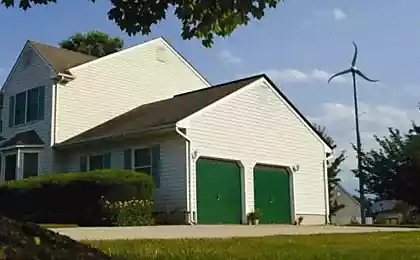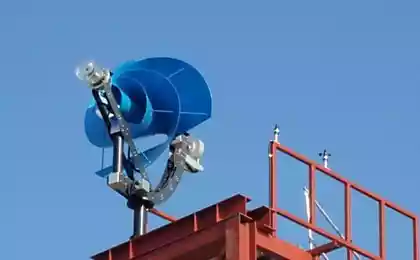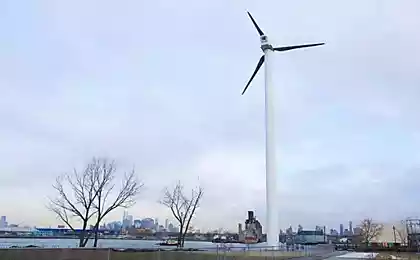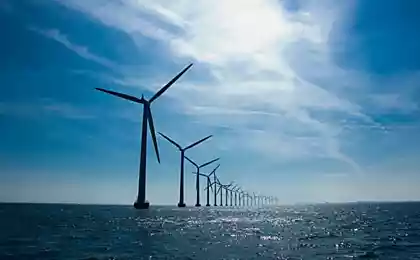482
New wind turbine carousel
In the modern world relied on renewable sources of energy, including wind energy. Dominated by the wind turbines of the propeller type with horizontal axis of rotation. These generators require a strong base of towers and step-up gearboxes, which increases the payback period. Besides, such aggregates are a powerful low-frequency sources of noise. These circumstances limit the range of buyers and makes the search for alternative to traditional wind power generators.
The newly created wind turbine is a renewable sources of energy in the form of vertical – axis wind turbines (VAWT international abbreviation) carousel.
Forty five million five hundred fifty one thousand eight hundred sixty one
The advantage of the rotor of vertical type is primarily lower the payback period, as well as what they will allow in a wide range of wind speeds. While rotors with a horizontal axis is translated to the protective autorotation at a certain maximum speed of the wind, the excess of which is fraught with destruction of the structure.
In this mode, the propeller is disconnected from the multiplier and the generator, electricity is not produced. But rotors with a vertical axis are experiencing significantly less stress at equal wind speed than the rotors with a horizontal axis. Besides, they require expensive systems of orientation in the direction of the wind.
While rotors with a vertical axis can work at any wind direction. Also the advantage of vertical rotors is their low noise and the possibility of installation in city buildings, including on the roofs of buildings.
In this project, proposed a fundamentally new approach to the design of vertical axis wind turbine of electricity. It is based on the low-lying solid rotor, on the periphery of which is fixed a variety of sail – wings.
The rotor is provided with supporting uprights a wheeled chassis, which allows him brasatsa around a fixed axis with a steady and sometimes on the Foundation due to the wheel chassis. Many sails – wings created by the aerodynamic forces large torque. What makes this design a record of power density. The rotor diameter may amount to 10 meters.
Thus at this rotor it is possible to install wings with an area of more 200квадратных meters, which will allow you to generate up to one hundred kilowatts of electricity. The weight of such aggregates is so small that it may be installed on the roofs of buildings and to provide them at the expense of the Autonomous power supply. Or possible to provide electricity to a big farm in the desert, where no paved power line. The power increase to arbitrarily high values attainable by the replication of these units. That is, putting a lot of the same type of wind turbines, achieved the desired power.
Fifty two million seven hundred twenty eight thousand three hundred forty seven
In the course of the Internet monitoring revealed an American company producing VAWT for residences, filling stations for electric vehicles, as well as for the Ministry of defense (electronic resource www.vortexis.com/vortexis-engineering.html)
When a remote resemblance with our American VAWT turbine, there are the following fundamental differences:
1. The analog rotates the inner part of the VAWT. And the outer part is the stator (stationary guide vanes). The inventive object, the whole system is a single rotor. Although it is possible to further match our turbine stator planes – microconcentrators.
2. Since the power depends on the torque which is directly proportional to the radius of the rotor, ceteris paribus, our turbine radius is larger (at same dimensions).
3. Our turbine has a horizontal impeller, unlike analog, which removes power from the upward vortex inside the rotor.
4. The analogue no sloping rear wings. In our system, they are, in an amount of from 9до 18. These wings, as shown by comparing the old model with nine spoilers and a new one with twice as many spoiler, increased power by 10 %.
5. The company cannot make large VAWT. The applicant designs the turbine power of 50...80 kW, which is a half order higher than the figures described analogue.
With regard to technical efficiency. Our prototype at a height of 800mm blades and a transverse dimension of 800 mm at a wind speed of 11 m/s has developed mechanical power 225 W (at 75 rpm). However, he defended the earth's surface at a height less than a meter. According to the resource www.rktp-trade.ru comparable power (300 W) develops a five-blade vertical wind turbine, mounted on a six-meter mast, and it has five 1200 mm blades fitted to the overall diameter of 2 000 mm.
Twenty four million six hundred seventy four thousand six hundred eighty five
That is, if you take sweeping wind area wind turbines compare equal, it turns out that the prototype energy efficient famous windmill in 2,5...3 times, given the fact that the earth the wind is weaker because of the proximity to the boundary surface and has a strong turbulent character. From this, knowing that the above analogy is the utilization of wind energy (KIEV) equal to 0.2, we can estimate KIEV prototype as 0.48, which is much higher than that of VAWT type "Savonius" and "Daria" and corresponds to the best world samples of horizontal – axis wind turbines.
The consumption of materials and the cost of the prototype is incomparably lower than the propeller mast of wind turbines that have mechanisms of orientation to the wind and high mounted power module with an expensive increasing gearbox of planetary type.
Comparative evaluation of the effectiveness of the rotors of wind turbines of various types are given in table 1 below.
Table1
The type of rotor
The location of the axis of rotation
The utilization of wind energy (KIEV)
Source
Notes
The Savonius Rotor
Vertical
0,17
R. A. Yanson. Wind turbine. Edited by M. J. Osipova. M.: IZDATEL'stvo MGTU im. N. Uh. Bauman, 2007. p. 23, Fig.Thirteen
Developed about eighty years ago, the scheme — Fig. 7 (d) on page 17 of the source
Rotor H-Darrieus with widely-spaced blades
Vertical
0,38
There
Developed about a century ago, the scheme — Fig. 7 (a) on page 17 of the source
Multiblade resistance
Vertical
0,2
There, as well as a specific commercial product on the website www.rktp-trade.ru
This type is widely known in Astana, the rotor of Bolotov.
Dwuhlopastny propeller
Horizontal
0,42
There
The most common type of wind turbines today
Rotor our turbine (formally N-Darya, but with tightly closed blades, which are mounted at an angle the rear wings and the horizontal impeller)
Vertical
0,48 0,5...
Full-scale measurements of wind velocity by anemometer, the torque of the rotor of the dynamometer, the speed of the rotor tachometer
KIEV determined by indirect methods. Direct measurement of the electric power generator to be purchased.
So, the present invention not only novel and non-obvious, but corresponds to the best world standards, KIEV, exceeding global standards for the associated costs and payback period.
In the future we plan to design, fabricate and test a full-size pilot sample. It is planned to establish mass production of such installations after debugging the pilot sample, with the equipment of such installations are not elektrifizierung of rural areas and new buildings in the cities.published
P. S. And remember, just changing your mind — together we change the world! ©
Source: ecotechnology
The newly created wind turbine is a renewable sources of energy in the form of vertical – axis wind turbines (VAWT international abbreviation) carousel.
Forty five million five hundred fifty one thousand eight hundred sixty one
The advantage of the rotor of vertical type is primarily lower the payback period, as well as what they will allow in a wide range of wind speeds. While rotors with a horizontal axis is translated to the protective autorotation at a certain maximum speed of the wind, the excess of which is fraught with destruction of the structure.
In this mode, the propeller is disconnected from the multiplier and the generator, electricity is not produced. But rotors with a vertical axis are experiencing significantly less stress at equal wind speed than the rotors with a horizontal axis. Besides, they require expensive systems of orientation in the direction of the wind.
While rotors with a vertical axis can work at any wind direction. Also the advantage of vertical rotors is their low noise and the possibility of installation in city buildings, including on the roofs of buildings.
In this project, proposed a fundamentally new approach to the design of vertical axis wind turbine of electricity. It is based on the low-lying solid rotor, on the periphery of which is fixed a variety of sail – wings.
The rotor is provided with supporting uprights a wheeled chassis, which allows him brasatsa around a fixed axis with a steady and sometimes on the Foundation due to the wheel chassis. Many sails – wings created by the aerodynamic forces large torque. What makes this design a record of power density. The rotor diameter may amount to 10 meters.
Thus at this rotor it is possible to install wings with an area of more 200квадратных meters, which will allow you to generate up to one hundred kilowatts of electricity. The weight of such aggregates is so small that it may be installed on the roofs of buildings and to provide them at the expense of the Autonomous power supply. Or possible to provide electricity to a big farm in the desert, where no paved power line. The power increase to arbitrarily high values attainable by the replication of these units. That is, putting a lot of the same type of wind turbines, achieved the desired power.
Fifty two million seven hundred twenty eight thousand three hundred forty seven
In the course of the Internet monitoring revealed an American company producing VAWT for residences, filling stations for electric vehicles, as well as for the Ministry of defense (electronic resource www.vortexis.com/vortexis-engineering.html)
When a remote resemblance with our American VAWT turbine, there are the following fundamental differences:
1. The analog rotates the inner part of the VAWT. And the outer part is the stator (stationary guide vanes). The inventive object, the whole system is a single rotor. Although it is possible to further match our turbine stator planes – microconcentrators.
2. Since the power depends on the torque which is directly proportional to the radius of the rotor, ceteris paribus, our turbine radius is larger (at same dimensions).
3. Our turbine has a horizontal impeller, unlike analog, which removes power from the upward vortex inside the rotor.
4. The analogue no sloping rear wings. In our system, they are, in an amount of from 9до 18. These wings, as shown by comparing the old model with nine spoilers and a new one with twice as many spoiler, increased power by 10 %.
5. The company cannot make large VAWT. The applicant designs the turbine power of 50...80 kW, which is a half order higher than the figures described analogue.
With regard to technical efficiency. Our prototype at a height of 800mm blades and a transverse dimension of 800 mm at a wind speed of 11 m/s has developed mechanical power 225 W (at 75 rpm). However, he defended the earth's surface at a height less than a meter. According to the resource www.rktp-trade.ru comparable power (300 W) develops a five-blade vertical wind turbine, mounted on a six-meter mast, and it has five 1200 mm blades fitted to the overall diameter of 2 000 mm.
Twenty four million six hundred seventy four thousand six hundred eighty five
That is, if you take sweeping wind area wind turbines compare equal, it turns out that the prototype energy efficient famous windmill in 2,5...3 times, given the fact that the earth the wind is weaker because of the proximity to the boundary surface and has a strong turbulent character. From this, knowing that the above analogy is the utilization of wind energy (KIEV) equal to 0.2, we can estimate KIEV prototype as 0.48, which is much higher than that of VAWT type "Savonius" and "Daria" and corresponds to the best world samples of horizontal – axis wind turbines.
The consumption of materials and the cost of the prototype is incomparably lower than the propeller mast of wind turbines that have mechanisms of orientation to the wind and high mounted power module with an expensive increasing gearbox of planetary type.
Comparative evaluation of the effectiveness of the rotors of wind turbines of various types are given in table 1 below.
Table1
The type of rotor
The location of the axis of rotation
The utilization of wind energy (KIEV)
Source
Notes
The Savonius Rotor
Vertical
0,17
R. A. Yanson. Wind turbine. Edited by M. J. Osipova. M.: IZDATEL'stvo MGTU im. N. Uh. Bauman, 2007. p. 23, Fig.Thirteen
Developed about eighty years ago, the scheme — Fig. 7 (d) on page 17 of the source
Rotor H-Darrieus with widely-spaced blades
Vertical
0,38
There
Developed about a century ago, the scheme — Fig. 7 (a) on page 17 of the source
Multiblade resistance
Vertical
0,2
There, as well as a specific commercial product on the website www.rktp-trade.ru
This type is widely known in Astana, the rotor of Bolotov.
Dwuhlopastny propeller
Horizontal
0,42
There
The most common type of wind turbines today
Rotor our turbine (formally N-Darya, but with tightly closed blades, which are mounted at an angle the rear wings and the horizontal impeller)
Vertical
0,48 0,5...
Full-scale measurements of wind velocity by anemometer, the torque of the rotor of the dynamometer, the speed of the rotor tachometer
KIEV determined by indirect methods. Direct measurement of the electric power generator to be purchased.
So, the present invention not only novel and non-obvious, but corresponds to the best world standards, KIEV, exceeding global standards for the associated costs and payback period.
In the future we plan to design, fabricate and test a full-size pilot sample. It is planned to establish mass production of such installations after debugging the pilot sample, with the equipment of such installations are not elektrifizierung of rural areas and new buildings in the cities.published
P. S. And remember, just changing your mind — together we change the world! ©
Source: ecotechnology





















